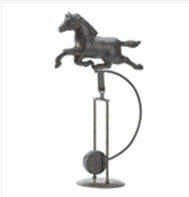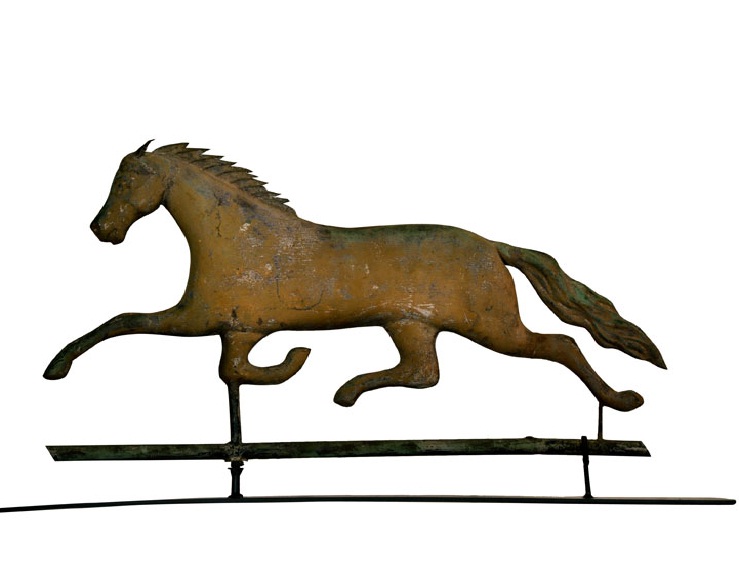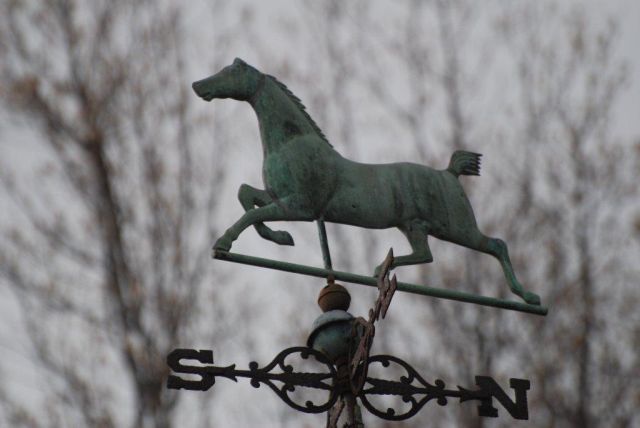| Home | First Posted: Aug 15, 2010 Jan 21, 2020 | |
Weather Vanes History and Horses
Have you ever dampened your finger and raised it to figure out which way the wind was blowing? Have you ever seen a farmer toss some dry leaves or dry dirt into the air to see which way they blow? Man has always been fascinated with the wind and the weather. Human kind has also been quite dependent upon Mother Nature's good nature or devastated by her wrath. Ancient cultures believed that the wind had divine powers. The design of weather vanes has been as varied as each culture and as creative as an individual's artistic ability. Like much of art weather vanes have often been symbolic. They have been made from many different materials: carved from wood, forged, made from copper, etc. The Tower of the Winds dates back to 48 BC and can be found in Athens, Greece. < The Tower of the Winds, also called horologion (timepiece), is an octagonal Pentelic marble clock tower on the Roman agora in Athens. The structure features a combination of sundials, a water clock and a wind vane. The weather vane depicted the Greek god Triton. Triton had the head and torso of a man and the tail of a fish. He was the god of the sea. It was supposedly built by Andronicus of Cyrrhus around 50 BC, but according to other sources might have been constructed in the 2nd century BC before the rest of the forum. The design of the 18th-century Radcliffe Observatory in Oxford, England, is based on the Tower of the Winds, as is the mausoleum of the founder of the Greek National Library Panayis Vagliano at West Norwood Cemetery, London. It has also inspired the 15th-century Torre del Marzocco in Livorno. There is a similar tower in Sevastopol, built in 1849. Another building based on the design of the Tower of the Winds is the Temple of the Winds, which stands in the grounds of Mount Stewart near Newtownards in Northern Ireland. SiteThe 12-metre-tall structure has a diameter of about 8 metres and was topped in antiquity by a weather vane-like Triton that indicated the wind direction. Below the frieze depicting the eight wind deities - Boreas (N), Kaikias (NE), Eurus (E), Apeliotes (SE), Notus (S), Livas (SW), Zephyrus (W), and Skiron (NW) - there are eight sundials. In its interior, there was a water clock (or clepsydra), driven by water coming down from the Acropolis. Recent research has shown that the considerable height of the tower was motivated by the intention to place the sundials and the wind-vane at a visible height on the Agora, making it effectively an early example of a clock tower. According to the testimony of Vitruvius and Varro, Andronicus of Cyrrhus designed the structure. In early Christian times, the building was used as the bell-tower of a Byzantine Church. Under Ottoman rule it became a tekke and was used by whirling dervishes. At that time it was buried up to half its height, and traces of this can be observed in the interior, where Turkish inscriptions may be found on the walls. It was fully excavated in the 19th century by the Archaeological Society of Athens. The Bayeaux Tapestry, (1.6 by 230 ft. long) is an embroidered cloth, not an actual tapestry, which depicts the events leading up to the Norman conquest of England as well as the events of the invasion itself. The Bayeux Tapestry is annotated in Latin. It is exhibited in a special museum in Bayeux, Normandy called Musée de la Tapisserie de Bayeux, with a Victorian-era replica in Reading, Berkshire. It depicts the scene of a (roste)r weathercock at Westminster Abbey. This tapestry was made in 1065, the 11th century. The pope, in the 19th century AD, asked that all European churches have a cock on top of the steeple or dome. This was to be a reminder that Jesus prophesied that the cock would not crow the morning after the Last Supper until Peter had denounced Him three times. Hence, the cock is often seen as a weather vane in both Europe and America. Weather vanes were used by the rich land owners throughout history. Weather Vane DerivationSo where might the weather vane have derived? As stated above the weather vane was part of ancient culture. In Old England the word "fane" which meant flag or banner gives us the word "vane." To define a weather vane one only has to think about the task to be accomplished--to determine which way the wind is blowing. Which direction is the wind coming from and which direction is it blowing? Weather vanes are generally made to point in the direction that the wind is blowing, are on a vertical rod, and must move freely. If the weather vane changes from west to east, this may be a signal that a mass of lower pressure is overhead and will bring storms. If the weather vane indicates a shift from the south or southwest, this may indicate that warmer air is on the way. If the vane is swinging erratically, this means the air is unstable and the current weather conditions are changing. The AmericasRecords indicate that the first weather vane maker in America was Deacon Shem Drowne of Boston. He made the grasshopper vane on the top of Boston's Faneuil Hall in 1742, the banner for Boston's Old North Church in 1740, the rooster that now stands atop the First Church in Cambridge, and the copper Indian that stands on Boston's Province House in 1716. <
Medieval nobility displayed their armour insignias on banner type weather vanes. If you were not of nobility pennants with single or double tails could be used. Men of lesser ranks were allowed to use pennants with either single or double tails called bannerets. The armour insignias were often put on weather vanes. In the 17th century, Christopher Wren, a well known English architect used the banneret design. In Concord, Massachusetts, the Concord Free Public Library has a banner weather vane that dates back to 1673.
Could weather vanes be considered as art? The answer to that question is a resounding yes! Weather vanes were first used in a functional way. However, the creators of these ingenious objects sculpted them to be symbolic. They often depicted a way of life, nature (fish, seagulls, wales, horses, pigs, chickens and other farm animals, etc.), ships, the environment, Coat of Arms, flags, arrow heads, Indians, angels, religion and culture. As the new world was being colonized weather vanes were displayed in places of prominence such as on church steeples and on top of watch towers. Their makers created them to depict the new culture and tradition of the Americas. The Goddess of Liberty became a patriotic weather vane after the revolution. The Federal Eagle also came into vogue in the 19th century. A Dove of Peace, crafted by Joseph Rakestraw of Philadelphia in 1787, was commissioned by George Washington. It is the weather vane at Mt. Vernon. Horses were an integral part of life and were one of the favorite subjects for weather vanes.
Horse Weather vanes
Early A. L. Jewell Prancing Horse Weather vane, United States, c. 1850
The silhouettes for many horse weather vanes were essentially copied from engraved prints of famous race horses, done by popular lithographers of the day, such as Currier & Ives. Each horse had its own running style (nose up, head flat forward, head perpendicular to the ground, etc.), which prompted their specific features. That is the case with Ethan Allen, a son of the equally famous "Blackhawk," from which another popular weather vane form was made. Several horses look very much like Ethan Allen, such as "Mountain Boy," "Goldsmith Maid," and "Prancing Dixie," and it can be effectively argued that any one is actually the other. There were so many weather vane manufacturers and so many subtle variations that students of the various forms must make reasonable guesses.  East Meets West USA
Famous racing horses were depicted on weather vanes. Smuggler, Black Hawk and George M. Patchen were modeled after the Currier and Ives prints:
Scores of weather vane designs were mass-produced in the 19th century. There were a number of makers who became famous: L.W. Cushing, J.W. Fiske, Harris & Co, and E.G. Washburne " Co. By the end of the century, elaborate metalwork weather vanes dawned Victorian buildings everywhere .A simpler life style that followed the Victorian age is depicted in the weather vanes also. They became a simple silhouette style, with many depicting sports or humorous figures.
 Westmoreland "Morley" Davis (August 21, 1859-September 7, 1942) at Morven Park, VA. |